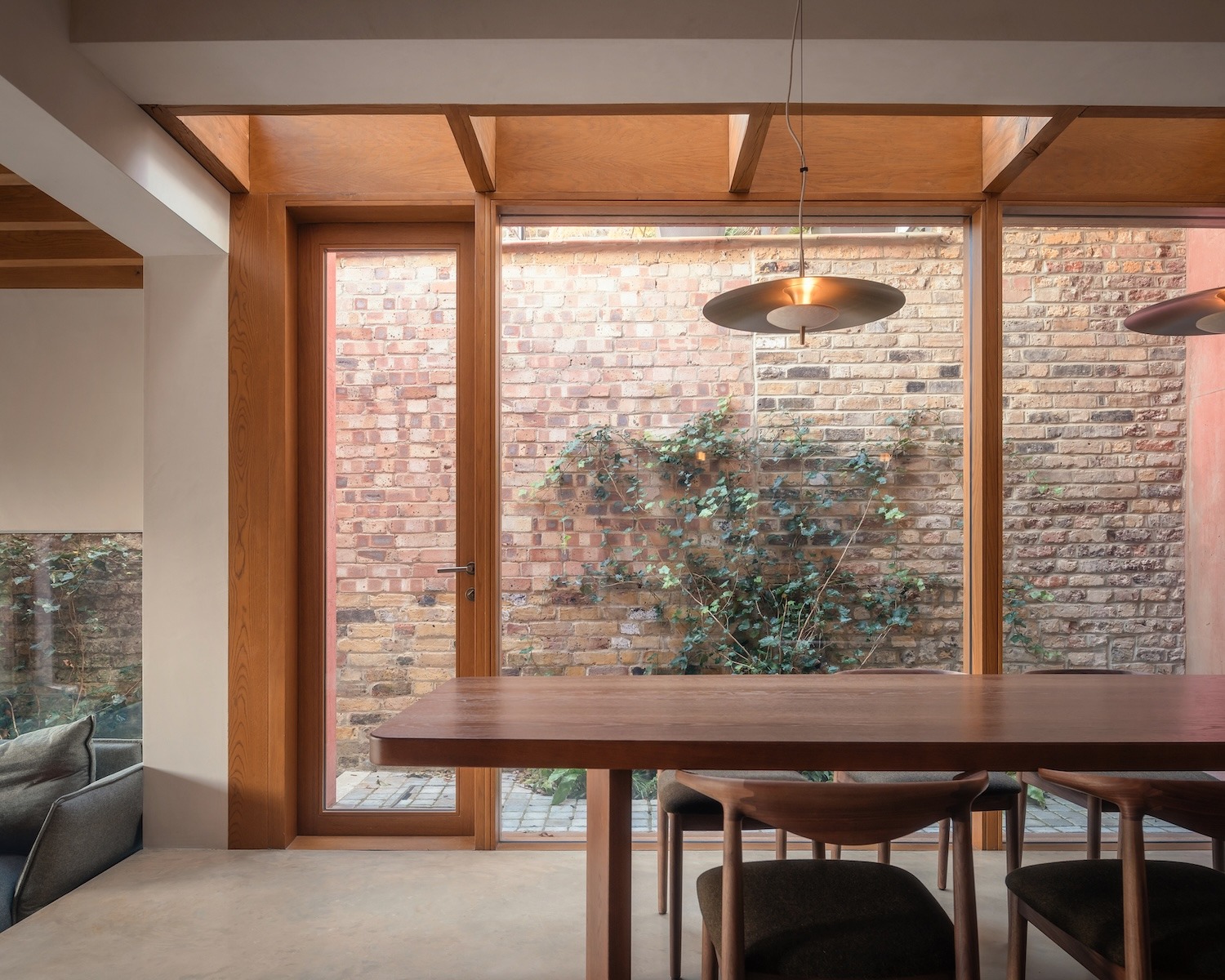"건축은 시간 속에서 만들어진 음악이다." - 프리드리히 셸링

시간을 가로지르는 건축적 대화 - 퍼트니 리버사이드 VATRAA-Putney Riverside
선택적 진정성이라는 새로운 보존 패러다임
런던 퍼트니의 템스강변, 빅토리아 시대 건물 하나가 조용한 변신을 거듭하고 있다. VATRAA가 설계한 이 프로젝트는 단순한 리노베이션을 넘어선 시간과의 대화를 보여준다. 건축가들은 일반적인 개발업자의 전면 철거라는 폭력적 방식 대신, 베니스 헌장 제12조를 창작의 나침반으로 삼았다.
그들이 수행한 것은 '건축적 수술'이라 부를 만한 정밀한 작업이었다. 습기로 인해 돌이킬 수 없는 손상을 입은 부분만을 선택적으로 제거하면서, 건물이 간직한 모든 회복 가능한 기억들을 세심하게 보존했다. 이는 보존을 과거에 대한 향수에서 과거와 현재 간의 창조적 대화로 전환시키는 접근이다.
우리나라의 전통 한옥 보존 작업에서도 비슷한 철학을 찾을 수 있다. 기존 목재 구조 중 건전한 부분은 그대로 두고 손상된 부재만을 교체하는 방식 말이다. 퍼트니 프로젝트는 이러한 동양적 보존 철학을 서구 맥락에서 구현한 흥미로운 사례다.
문화적 융합을 담아낸 재료의 서사
내부 공간의 재료 구성은 그 자체로 문화적 여행의 이야기를 담고 있다. 스리랑카 목재의 따스한 톤에 맞춰 염색된 오크 바닥재는 영국 빅토리아 시대의 견고함과 남아시아의 정서적 온기를 하나로 엮어낸다.
겉보기에 단순한 이 색채 선택은 프로젝트의 깊은 철학을 드러낸다. 건물의 영국적 뼈대를 존중하면서도 거주자의 문화적 정체성을 자연스럽게 품어내겠다는 의지다. 오크와 콘크리트, 라임 플라스터가 어우러져 만들어내는 재료적 대화는 뿌리 깊으면서도 세계적인 감성을 자아낸다.
경계를 해체하는 혁신적 공간 전략
후면의 콘크리트 파사드는 건축가들의 정교한 사고를 보여주는 백미다. 그 테라코타 색조는 원래 건물의 붉은 벽돌 창문 아치에서 추출한 것으로, 뚜렷이 현대적인 형태를 도입하면서도 기존 건물과의 시각적 연속성을 자연스럽게 만들어낸다.
특히 주목할 만한 것은 완전히 열렸을 때 발코니 난간으로 변모하는 대형 새시 창이다. 이는 단순한 복원을 넘어선 창의적 해석의 결과물이다. 1층의 프렌치 도어들은 실내와 템스강변 풍경 사이의 경계를 완전히 해체한다. 건축가들의 표현을 빌리면 "정원을 집 중심부로 초대하는" 마법 같은 장치다.
정직한 개입이 만들어내는 시간의 기록
VATRAA의 방법론은 '선택적 진정성'이라는 새로운 개념으로 정의할 수 있다. 원래 플라스터의 80%가 습기로 소실된 상황에서도, 그들은 구조적으로 건전한 부분만을 보존하고 손실된 구간을 새로운 라임 플라스터로 메워 나갔다.
새로운 부분은 "구별되지만 조화로운" 상태로 남겨두었다. 이는 복원 과정에서의 개입을 숨기지 않겠다는 정직한 의지의 표현이다. "외과의사처럼 꼭 필요한 부분만 제거하고 필요한 곳을 정확히 보완한다"는 그들의 철학은 기술적 제약을 오히려 창작의 동력으로 전환시켰다.
현실적 제약을 창의로 풀어낸 지하공간
지하실 증축은 경제성과 보존 가치 사이의 균형점을 찾아낸 영리한 해법이다. 리노베이션 비용을 상쇄하면서 생활공간을 확보하기 위해 땅 아래로 파들어간 이 방식은 보존지구의 가로경관에 기여하는 정면 파사드를 전혀 해치지 않는다.
게임룸과 전면 정원을 연결하는 라이트웰은 지하공간의 한계를 뛰어넘는 공간적 발명이다. 자연광이 수직으로 스며들어 지하에서도 계절의 변화를 느낄 수 있게 한다. 길게 뻗은 1층 평면은 전략적 재료 선택과 공간 구성을 통해 템스강의 빛을 집 깊숙이까지 끌어들인다.
퍼트니 리버사이드는 보존이란 무엇인가에 대한 근본적 질문을 던진다. 과거를 박제하는 것이 아니라 역사를 살아 숨 쉬는 현재로 전환시키는 창조적 행위로서의 보존 말이다.
VATRAA는 기술적 정밀함과 문화적 감수성을 결합하여 건축이 어떻게 시간을 가로질러 대화할 수 있는지 보여주었다. 이 프로젝트는 우리나라의 도시 재생과 역사 보존이 직면한 과제들에도 귀중한 시사점을 제공한다. 전면 철거와 복원 사이의 제3의 길, 그것은 바로 정직하고 창의적인 개입을 통한 시간과의 협업이다.
Write by Claude & Jean Browwn











Putney Riverside is a conservation and extension project located in London, United Kingdom, designed by VATRAA. The architects approached this project with the precision of art restorers, embracing Article 12 of The Venice Charter as both constraint and catalyst. Rather than the typical developer’s erasure, they performed what might be called “architectural surgery,” selectively removing only what dampness had irreparably damaged while preserving every salvageable fragment of the original character. The result transforms conservation from nostalgic exercise into dynamic dialogue between past and present.
The interior palette tells a compelling story of cultural migration. Oak flooring, stained to match Sri Lankan timber tones, creates an unexpected bridge between English Victorian domesticity and South Asian heritage. This chromatic choice – seemingly simple reveals the project’s deeper ambition: to honor both the building’s English bones and the inhabitants’ cultural memory. The combination of oak, concrete, and lime plaster creates a material conversation that feels both rooted and cosmopolitan.
The concrete rear facade demonstrates particularly sophisticated thinking. Its terracotta hue derives from the original red brick window arches, creating visual continuity while introducing distinctly contemporary forms. Those oversized sash windows – which transform into balcony balustrades when fully opened represent the kind of innovative detail that distinguishes thoughtful restoration from mere replication. The French doors at ground level dissolve the boundary between interior and Thames-side landscape, creating what the architects describe as inviting “the garden towards the middle of the house.”
VATRAA’s methodology embodies what might be termed “selective authenticity.” Where 80% of the original plaster succumbed to damp damage, they preserved only what remained structurally sound, then completed missing sections with new lime plaster that remains “distinguishable but complementary.” This approach refuses both wholesale demolition and sentimental fiction, instead creating an honest record of intervention. The practice speaks of acting “like a surgeon, only removing the unnecessary parts and making good where needed” a philosophy that transforms technical constraint into creative opportunity.
The basement addition exemplifies pragmatic conservation. By digging down to offset renovation costs while gaining space, the architects solved economic constraints without compromising the street facade’s contribution to the conservation area. The lightwell connecting games room to front garden demonstrates how contemporary spatial needs can be accommodated within heritage frameworks, while the elongated ground floor plan maximizes natural light penetration through strategic material choices and spatial organization.
form leibal